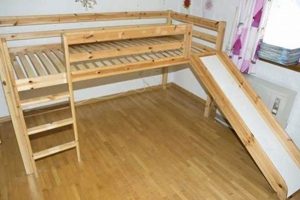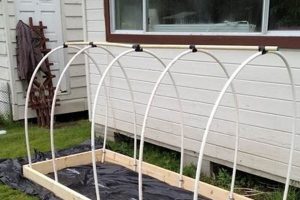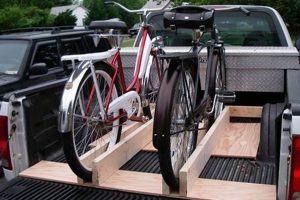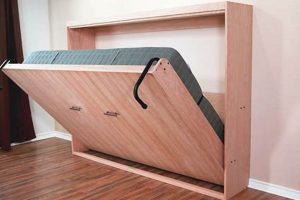Creating a defined border around cultivated areas using readily available materials and personal labor constitutes a popular landscaping practice. This method involves constructing physical boundaries utilizing items like wood, stone, brick, or recycled materials to delineate planting zones, as seen in the bordering of vegetable patches or flower arrangements.
The application of such borders offers several advantages, including aesthetic enhancement, prevention of soil erosion, and control of weed encroachment. Historically, these structures have served as practical necessities in maintaining organized and productive gardens, evolving from simple barriers to decorative elements reflecting personal style and resourcefulness.
The following sections will explore various materials suitable for crafting such borders, offer guidance on installation techniques, and provide examples of innovative designs to inspire personalized garden layouts.
Practical Considerations for Garden Border Construction
The subsequent points offer guidance for achieving durable and aesthetically pleasing garden borders. Careful planning and execution are essential for optimal results.
Tip 1: Material Selection: Prioritize materials resistant to degradation from moisture and sunlight. Treated lumber, natural stone, or durable plastics offer longevity compared to untreated wood or easily fractured materials.
Tip 2: Foundation Preparation: Ensure a stable base by excavating a shallow trench along the intended border line. Compacting the soil within the trench minimizes settling and maintains border alignment.
Tip 3: Precise Alignment: Utilize a level and string line to guarantee horizontal accuracy during installation. Deviations from level can compromise visual appeal and structural integrity.
Tip 4: Secure Anchoring: Employ stakes or landscape adhesive to firmly secure border elements. This prevents shifting due to soil movement, frost heave, or incidental contact.
Tip 5: Drainage Considerations: Incorporate drainage gaps, particularly in solid borders, to prevent water accumulation behind the structure. Excess moisture can lead to soil saturation and plant root rot.
Tip 6: Height Consistency: Maintain a uniform border height for visual consistency. Variations in height can appear unplanned and detract from the overall aesthetic.
Tip 7: Soil Compatibility: Select materials that do not leach harmful chemicals into the soil. Certain treated woods or recycled plastics may contain substances detrimental to plant health.
Implementing these strategies contributes to the creation of effective and enduring garden borders. Careful attention to detail ensures both functional benefit and aesthetic value.
The final portion of this discussion will synthesize the presented information and offer concluding remarks on the importance of thoughtful garden border construction.
1. Material Durability
Material durability constitutes a primary consideration in the context of garden bed edging projects. The inherent capacity of a selected substance to withstand environmental degradation directly influences the longevity and structural integrity of the border. Premature deterioration necessitates frequent repairs or complete replacement, increasing both labor and material costs. Therefore, informed material selection based on inherent resistance to decay, moisture, and ultraviolet radiation is paramount. For instance, untreated softwood, while initially cost-effective, succumbs rapidly to rot in damp soil, rendering it unsuitable for long-term edging solutions. Conversely, pressure-treated lumber, certain hardwoods like cedar, or composite materials offer superior resistance to decomposition, significantly extending the lifespan of the garden border.
The practical significance of understanding material durability manifests in several ways. Initial material expense must be weighed against projected lifespan; a more expensive, durable material may prove more economical over time. Furthermore, the choice of material impacts the ongoing maintenance requirements of the garden border. Materials prone to cracking, warping, or discoloration demand regular upkeep to preserve their appearance and structural soundness. Coastal environments, with increased exposure to salt spray and humidity, necessitate even greater emphasis on durability. For example, concrete edging, while robust, may be susceptible to spalling in regions with frequent freeze-thaw cycles unless specifically formulated for such conditions. Similarly, metal edging requires careful consideration of corrosion resistance, with galvanized steel or aluminum representing viable options.
In summary, prioritizing material durability in garden bed edging projects is crucial for achieving a lasting and functional outcome. Failure to adequately assess the environmental conditions and material properties leads to increased maintenance, premature failure, and ultimately, higher costs. A balanced approach, considering both immediate expense and long-term performance, ensures a cost-effective and aesthetically pleasing garden border solution.
2. Installation Stability
Installation stability represents a critical determinant of the longevity and efficacy of garden bed edging. Improper installation compromises the structural integrity of the border, leading to displacement, deformation, and eventual failure, thereby negating the intended benefits of delineation and containment.
- Foundation Preparation
Adequate foundation preparation is paramount for ensuring border stability. This entails excavating a trench of sufficient depth and width to accommodate the edging material. Compacting the soil within the trench provides a firm and level base, minimizing settling and preventing subsequent shifting of the edging. Without proper foundation preparation, even robust edging materials are prone to displacement due to soil erosion, frost heave, or physical disturbances.
- Anchoring Techniques
Effective anchoring techniques are essential for securing the edging material in place. This may involve the use of stakes, pins, or landscape adhesive, depending on the type of material employed. Stakes or pins driven into the ground at regular intervals provide lateral support, preventing leaning or toppling. Landscape adhesive bonds the edging material to the underlying surface, increasing resistance to movement. The selection of appropriate anchoring methods depends on factors such as soil type, edging material, and anticipated environmental stresses.
- Joint Stabilization
In installations involving multiple segments of edging material, proper joint stabilization is crucial for maintaining structural integrity. Overlapping or interlocking designs provide inherent stability, while adhesive or mechanical fasteners may be necessary for butt joints. Unsecured joints represent weak points in the border, susceptible to separation or displacement under stress. Consistent joint stabilization ensures a cohesive and durable edging structure.
- Backfilling and Compaction
Following installation, backfilling around the edging material and compacting the soil provides additional stability and support. Backfilling eliminates voids behind the edging, preventing soil erosion and undermining. Compaction increases soil density, reducing the likelihood of settling or shifting. Proper backfilling and compaction enhance the overall stability and longevity of the garden bed edging.
Collectively, these facets underscore the importance of meticulous installation practices in maximizing the functional lifespan of the garden bed edging. Neglecting any of these aspects can compromise the stability of the border, necessitating premature repairs or replacement. Proper installation, therefore, constitutes a critical investment in the long-term performance and aesthetic value of the garden.
3. Aesthetic Integration
Aesthetic integration, in the context of “diy garden bed edging,” pertains to the harmonious blending of the edging material and design with the existing garden landscape and architectural style of the property. It moves beyond mere functionality, aiming to enhance the overall visual appeal and create a cohesive and pleasing environment.
- Material Harmony with Existing Elements
The selection of edging materials should complement the existing elements within the garden and surrounding environment. For instance, a cottage-style garden with abundant floral displays might benefit from the use of natural stone or reclaimed brick edging, materials that possess inherent texture and rustic charm. Conversely, a modern, minimalist garden may be better suited to sleek metal or concrete edging, which provides clean lines and a contemporary aesthetic. The failure to consider the existing visual context can result in an edging design that appears incongruous and detracts from the overall beauty of the landscape.
- Color Palette Consistency
The color palette of the edging should harmonize with the colors of the surrounding plants, structures, and hardscape features. A monochromatic color scheme, utilizing variations of a single color, can create a sense of unity and sophistication. Alternatively, a complementary color scheme, employing colors that are opposite each other on the color wheel, can create a more vibrant and dynamic effect. Careful consideration of color relationships is essential for achieving a visually balanced and appealing garden design. For example, using brightly colored plastic edging in a garden dominated by muted earth tones could appear jarring and out of place.
- Form and Texture Compatibility
The form and texture of the edging should align with the overall style and character of the garden. A formal garden, characterized by symmetry and geometric shapes, may benefit from straight, clean-lined edging made from materials with a smooth texture. An informal garden, with its more naturalistic and organic design, might be enhanced by curved edging constructed from rough-hewn stone or weathered wood. The interplay of form and texture contributes significantly to the overall aesthetic impact of the garden bed edging.
- Scale and Proportion Considerations
The scale and proportion of the edging should be appropriate for the size of the garden bed and the surrounding landscape. Overly large or imposing edging can overwhelm a small garden, while undersized or delicate edging may be lost in a larger setting. Careful consideration of scale and proportion ensures that the edging is visually balanced and contributes to the overall harmony of the garden design. For instance, using large boulders as edging in a small raised bed would likely appear disproportionate and create a sense of visual imbalance.
By carefully considering these facets of aesthetic integration, practitioners of “diy garden bed edging” can create borders that not only serve a functional purpose but also enhance the beauty and value of their outdoor spaces. The successful integration of edging into the overall landscape requires a thoughtful and deliberate approach, prioritizing visual harmony and consistency with the existing environment.
4. Soil Compatibility
Soil compatibility is a crucial, yet often overlooked, aspect of crafting garden bed edging. The selection of inappropriate materials can lead to detrimental effects on soil chemistry, plant health, and the overall ecosystem of the garden.
- Leaching of Harmful Substances
Certain materials used in garden bed edging can leach chemicals into the surrounding soil. Treated lumber, while durable, may contain preservatives like chromated copper arsenate (CCA), which can contaminate the soil with arsenic, chromium, and copper. These substances can be toxic to plants and pose health risks to humans. Similarly, some recycled plastics may release volatile organic compounds (VOCs) or other harmful additives into the soil environment. Choosing inert materials or those specifically designed for garden use minimizes the risk of soil contamination.
- Alteration of Soil pH
Edging materials can alter the pH level of the adjacent soil. Concrete, for instance, is alkaline and can raise the soil pH over time, potentially affecting the availability of essential nutrients to plants. Plants adapted to acidic soils, such as blueberries and azaleas, may suffer if planted near concrete edging. Conversely, certain types of wood, as they decompose, can slightly lower the soil pH. Understanding the pH preferences of plants and the potential impact of edging materials is crucial for maintaining optimal growing conditions.
- Impedance of Soil Drainage and Aeration
Impenetrable edging materials, such as solid concrete or plastic, can impede soil drainage and aeration. This can lead to waterlogged soil conditions, which promote anaerobic bacteria and root rot. Poorly aerated soil also restricts the uptake of essential nutrients by plant roots. Permeable edging materials, like loosely stacked stones or gravel, allow for better drainage and aeration, promoting healthier soil and plant growth. Consideration should be given to the soil type and the water requirements of the plants when selecting edging materials.
- Influence on Soil Microbial Activity
The type of edging material can indirectly influence soil microbial activity. Certain materials may provide a favorable habitat for beneficial microorganisms, while others may inhibit their growth. For example, wood edging can support the growth of fungi and bacteria that contribute to the decomposition of organic matter and the release of nutrients into the soil. Conversely, synthetic materials may have a limited impact on soil microbial communities. Maintaining a healthy soil microbiome is essential for nutrient cycling, disease suppression, and overall soil health.
The interplay between soil and edging material dictates the long-term success of any “diy garden bed edging” project. A keen understanding of these interactions allows for informed decisions, fostering a thriving garden ecosystem. Choosing appropriate materials that do not negatively impact soil chemistry, drainage, or microbial activity will result in healthier plants and a more sustainable garden environment.
5. Drainage Provision
The adequate management of water flow represents a critical factor in the design and construction of garden bed edging. Impermeable edging materials, when improperly installed, can impede natural drainage patterns, leading to water accumulation behind the border. This excess moisture saturates the soil, fostering anaerobic conditions that inhibit root respiration and promote the proliferation of root-rot pathogens. Consequently, plant health declines, and the effectiveness of the edging as a means of defining and enhancing the garden is undermined. The selection of edging materials and installation techniques must, therefore, account for existing drainage characteristics to prevent deleterious effects on plant life and soil integrity. A practical example is the use of solid concrete edging without weep holes in a heavy clay soil; this configuration invariably leads to waterlogged conditions following significant rainfall.
Proper drainage provision involves several strategies. The incorporation of permeable materials, such as loosely stacked stone or gravel, facilitates the lateral movement of water, mitigating the risk of saturation. The installation of weep holes or drainage gaps at regular intervals along the edging allows accumulated water to escape, preventing the buildup of hydrostatic pressure. Furthermore, grading the soil surface away from the edging promotes surface runoff, reducing the volume of water that infiltrates the soil behind the border. For instance, constructing a French drain behind a solid timber edging effectively intercepts subsurface water flow, channeling it away from the planting area. These techniques require a thorough understanding of local soil conditions, rainfall patterns, and the water requirements of the selected plants.
In summary, drainage provision constitutes an integral component of successful “diy garden bed edging.” Failure to address this critical factor results in compromised plant health, increased maintenance requirements, and a diminished aesthetic appeal. Integrating permeable materials, weep holes, and appropriate grading strategies ensures optimal soil moisture levels, promoting thriving plant life and maximizing the long-term functionality and visual impact of the garden border. The challenges associated with drainage management underscore the importance of careful planning and execution in all garden edging projects.
Frequently Asked Questions
This section addresses common inquiries regarding the construction and maintenance of garden bed edging, providing concise and authoritative responses to ensure optimal project outcomes.
Question 1: What are the primary factors to consider when selecting materials for garden bed edging?
Material selection hinges on several factors, including durability, resistance to weathering, aesthetic compatibility with the landscape, and potential environmental impact. Prioritize materials that withstand moisture, sunlight, and temperature fluctuations while complementing the garden’s overall design. Consideration should also be given to materials that do not leach harmful chemicals into the soil.
Question 2: How does foundation preparation affect the longevity of garden bed edging?
Thorough foundation preparation is crucial for ensuring the stability and longevity of garden bed edging. Excavating a shallow trench, compacting the soil, and ensuring a level base minimizes settling and prevents displacement caused by frost heave or erosion. Neglecting this step can compromise the structural integrity of the edging, leading to premature failure.
Question 3: What techniques are recommended for securing garden bed edging in place?
Effective anchoring methods depend on the type of edging material used. Stakes or pins driven into the ground provide lateral support for flexible materials like plastic or metal. Landscape adhesive bonds rigid materials, such as stone or brick, to the underlying surface. The chosen technique should withstand anticipated environmental stresses and prevent shifting or toppling of the edging.
Question 4: How does garden bed edging affect soil drainage, and what measures can mitigate potential problems?
Impermeable edging materials can impede soil drainage, leading to waterlogged conditions. To mitigate this, incorporate permeable materials, such as loosely stacked stone or gravel, or install weep holes in solid edging to allow water to escape. Grading the soil surface away from the edging also promotes surface runoff and reduces water accumulation.
Question 5: What are the potential environmental concerns associated with certain garden bed edging materials?
Some edging materials, such as treated lumber containing chromated copper arsenate (CCA), can leach harmful chemicals into the soil. Recycled plastics may also release volatile organic compounds (VOCs). Opting for inert materials or those specifically designed for garden use minimizes the risk of soil contamination and protects plant health.
Question 6: How can the aesthetic integration of garden bed edging be optimized?
Aesthetic integration involves harmonizing the edging material and design with the existing landscape and architectural style. Consider the color palette, form, texture, and scale of the edging in relation to the surrounding elements. A cohesive design enhances the visual appeal of the garden and creates a unified and pleasing environment.
In summary, the successful implementation of garden bed edging necessitates careful consideration of material properties, installation techniques, and environmental factors. Adherence to these principles ensures a durable, functional, and aesthetically pleasing outcome.
The following section will offer concluding remarks, summarizing the key insights presented and emphasizing the overall importance of informed garden bed edging practices.
DIY Garden Bed Edging
This exploration of diy garden bed edging has elucidated the critical factors governing its successful implementation. From material selection and installation stability to aesthetic integration and soil compatibility, each element contributes to the creation of functional and visually appealing garden borders. The long-term effectiveness of these borders depends on a comprehensive understanding of these principles and a commitment to sound construction practices.
Ultimately, thoughtful application of diy garden bed edging transcends mere landscaping. It represents an investment in the health and beauty of the garden ecosystem, fostering a sustainable and aesthetically pleasing outdoor environment. Continued adherence to informed practices will ensure the enduring value and functionality of garden borders for years to come.







